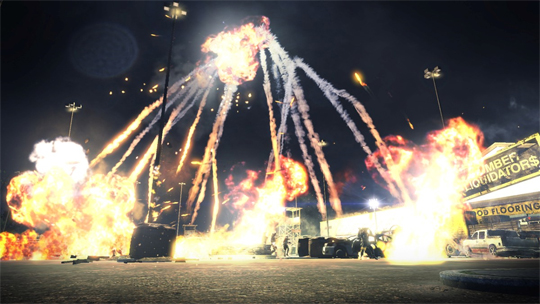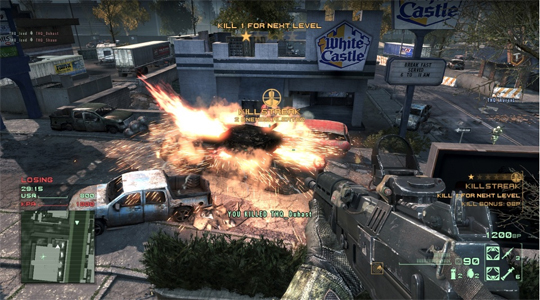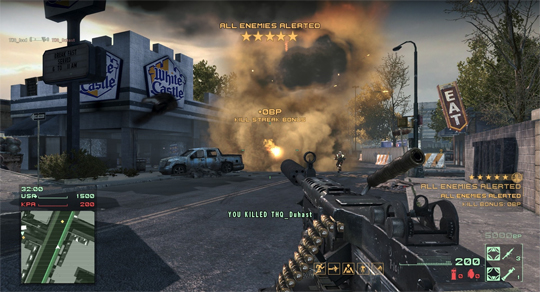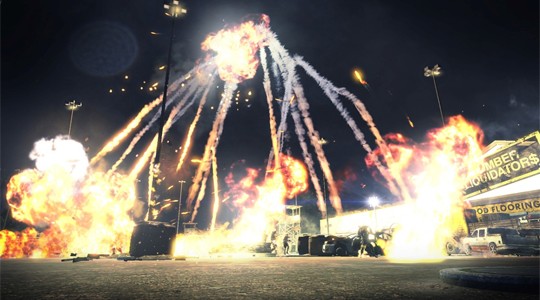
If there is one way I can describe Homefront, the new shooter from Frontlines: Fuel of War developer Kaos Studios, it’s what would have happened if the Colorado teens from Red Dawn grew up playing Call of Duty before the Russians invaded their town. It’s a curious game that really does little wrong, but never excels at anything more than what it sets out to do.
The game is set in 2027, an alternate future where North and South Korea have become one country, forming the Greater Korean Republic (GKR). Under the leadership of Kim Jong-un, the GKR has rapidly expanded, taking over much of Southeast Asia and Japan. As the U.S. begins a massive economic downfall, the GKR launch a satellite which fires an EMP blast at the U.S., and soon, the Korean People’s Army (KPA) invades, occupying America.
This is all told in a stunning intro cutscene that cuts real footage with CGI scenes to create what appear to be very real news broadcasts. The game then transitions you into control of Robert Jacobs, a pilot who is being loaded onto a bus and taken to a “reeducation camp” with other pilots and army officials. Homefront scores its second emotional volley here, where you see American citizens being beaten, lined up, and forced into labor camps by KPA soldiers during your bus ride. There’s a provocative scene where you’ll witness a child’s parents being executed as he watches on and this all builds up into making you want to get a gun and start fighting back as soon as possible.

Unfortunately, once you get that gun, the single-player campaign begins a slow degradation into mediocrity. Play essentially equates to you running into an area, being forced to take cover, and eliminating numerous KPA soldiers. Once you clear the area, you can move into your next area where you repeat the process for the entire campaign. There are some great action set pieces sprinkled throughout the game’s seven levels, like commanding a remote tank to take out enemy vehicles or fighting your way out of a department store as it burns and crumbles around you, but these are few and far between.
The only things the single-player mode has going for it is that it’s short and the story is good. I finished it clocking in at around three and a half hours, never allowing the average gameplay to drag on. This also gave enough time for the story, written by Red Dawn and Apocalypse Now scribe John Milius, which deserved a better compliment than the game design on offer. The characters are as fleshed out as they need to be, you spend quite a lot of time with your squad building a rapport, and the emotional moments are nailed appropriately.
The short single-player component also allows you to quickly get into what I believe is Homefront‘s main attraction. The game’s multiplayer is simply excellent. Kaos Studios took the now-standard XP progression system that is present in every first-person shooter and added their own twist to it. As you gain XP, you’ll also gain Battle Points, or BP. The more you contribute, be it by capturing a control point or by killing opposing players, the more BP you get. You’ll use BP to purchase in-match upgrades, like remote-controlled drones, UAV planes, or vehicles for your team to use. As you level up, you’ll unlock more upgrades to add to your class that you can buy mid-match. In Battle Commander variants, you’ll gain even more BP for killing a player who is doing really well or capturing a certain Control Point as dictated by your commander. It’s a more interesting system than the standard killstreak/deathstreak we’ve seen before, and it rewards you for both teamwork as well as succeeding on a personal level in matches.

The maps that ship with Homefront are all great, supporting from 8- to 32-player variants. There is plenty of cover, interesting locales, and wide-open spaces to support any type of player. One of my favorite maps took place in a shopping district, where players could hold up in the White Castle restaurant, take refuge in a convenience store, or take the fight to a Hooters bar. It may be blatant product placement, but in a game about America being occupied, it fit well.
The art design of a war-torn American is conveyed very well in the game’s environments, and it always made me feel I was trekking through someone’s actual home, sometimes as they were still squatting in it, on my way to my next kill arena. Although the technical aspects of the environments and character models fall short of the prettier titles of the current generation, I must point out the gun rendering, which is superb. All of the tiny switches, writing, and moving parts of the guns are there, and they have an audible kick as well, sounding powerful and destructive. Explosions, crackling fire, and the characters’ voices as they shouted are all done well, too.
Homefront is a solid, if uneven, experience that features an excellent multiplayer mode, with a very average single-player campaign attached. It won’t capture your imagination in any way, but if you’re a devoted multiplayer gamer, you will find a lot to love here.


















